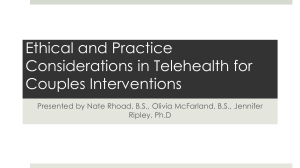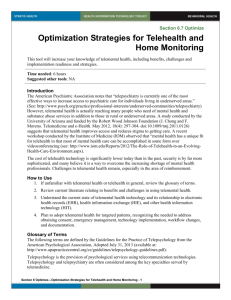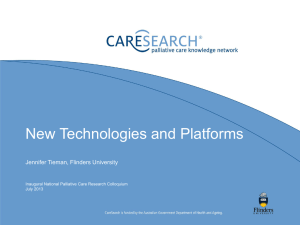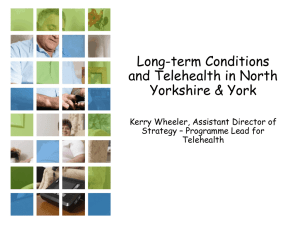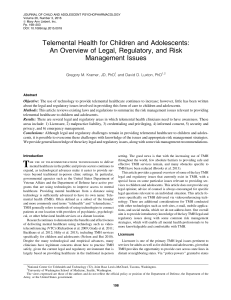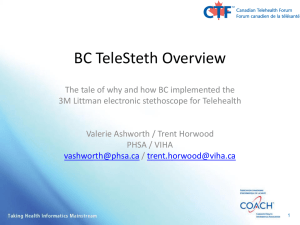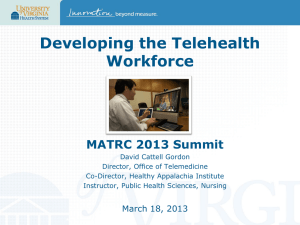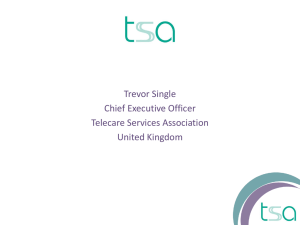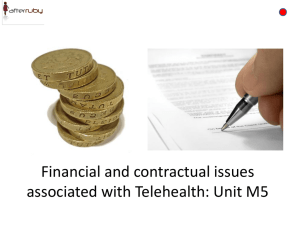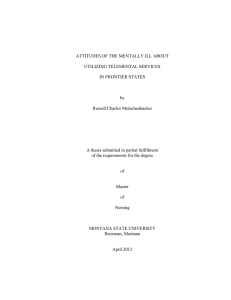VA Psychology Training Programs CVT presentation
advertisement
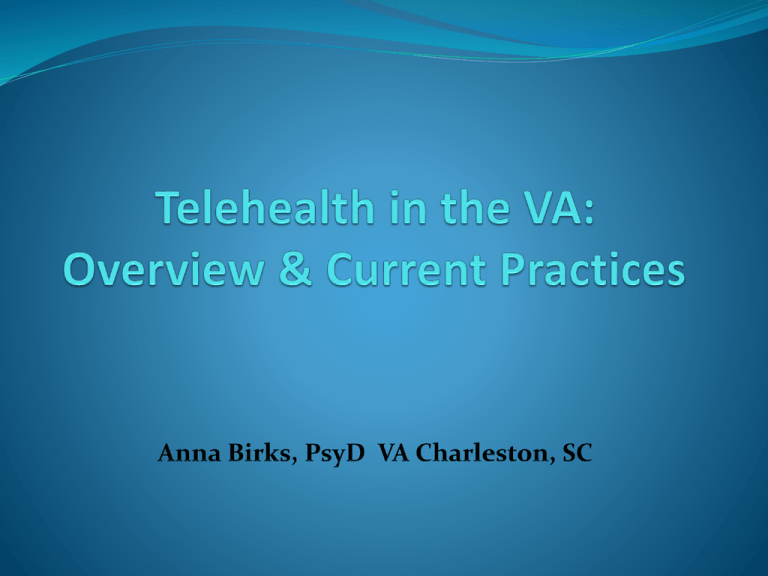
Objectives To provide a basic introduction to TMH. Provide an overview of the current uses of TMH. Educate providers on the clinical considerations before providing TMH. Educate providers on the pertinent risk issues of TMH. Provide a list of current TMH resources. Contributors Ron Acierno, Ph.D., Anna Hynes Birks, Psy.D., Kathleen Chard, Ph.D.; Lana Frankenfield, LCSW; Linda Godleski, M.D.; Carolyn Greene, Ph.D.; Leslie Morland Psy.D.; Peter Shore, Psy.D.; Tracey Smith Ph.D.; Steven Thorp, Ph.D.; Peter Tuerk Ph.D.; Matthew Yoder, Ph.D. The goal of the telehealth provider is to eliminate disparities in patient access to quality, evidencebased, and emerging health care diagnostics and treatments. -American Telemedicine Association, (2009, July). Evidence-based practice for telemental health Definitions •Telemedicine is the use of medical information exchanged from one site to another via electronic communications to improve patients' health status. •"telehealth," which is often used to encompass a broader definition of remote healthcare that does not always involve clinical services. •The term e-health is often used to describe automated web-based products and services to deliver health-related education or secondary prevention services. *Tuerk, Peter Clinical Summit, 2012 What is Telemental Health? “The term telemental health services typically refers to behavioral health services that are provided using communication technology” National Center for PTSD Fact Sheet “PTSD and Telemental Health” TMH Clinical Video Telehealth (CVT) Typical VA Telemental Health Program Majority of Telemental Health Activity is Hub and Spoke model Provides Access to General Mental Health Services and Medical Center Specialists for Patients in Remote CBOCs Ease of Implementation: Same Credentialing and Privileging Same Medical Record Same Workload and Reimbursement Mechanism Same Quality Management Oversight Same IT Department and IT Infrastructure Benefits of Telemental Health Technology is rapidly increasing system coverage area, thereby 1 increasing the reach to rural veterans 5 Patient benefits with regard to lost employment time, as well as transportation costs and time 2-4 Satisfaction with service delivery is high among patients and providers 6-7 Efficacy data in telemental health: limited but supportive 8 Lower cost without sacrificing quality of care 1 Decreased hospitalization utilization by an average of approximately 25% (Godleski, 2012) Morland et al., 2003; 2 Bose et al., 2001 ; 3 Elford et al., 2000 ; 4 Trott & Blignault, 1998; 5 Dunn et al., 2000 ; 6 Frueh et al., 2000; 7 Monnier et al., 2003; 8 Ruskin et al., 2004 Use of Clinical Video Telehealth For all diagnoses, with rare exclusions For a range of populations By all mental health clinicians For a range of mental health procedures At multiple sites of care Evidence Base for CVT American Telemedicine Association (2011): • Inpatient and outpatient mental health evaluations • Diagnostic interviews • Psychiatry (assessment, treatment and monitoring) • Psycho-Education • Individual and Group Psychotherapy • Marital and Family Psychotherapy Evidence Base Cont. • Psychological Assessment • Diagnostic instruments and scales • Personality Assessment • Neuropsychological Assessment *See Turner et al (2012); Amarendran et al (2011); Cullum et al (2006); McEachern et al (2008) Research Base Empirical Studies Uncontrolled studies (26) Nonrandomized controlled studies (9) Randomized controlled studies (12) Lana Frankenfield Human Connection & Technology “It seems so cold, the human element is missing from the encounter” “Telehealth doesn’t seem safe” “It’s less effective than a ‘real’ encounter” “Patients will not like it” What is a TMH Telepresenter Front Line Staff LPN RN Telehealth Clinical Technician (TCT) The Role of the TMH Telepresenter Initial Visit Explain Telemental health Verbal informed consent Outline the experience the patient can expect Reassure that the patient will not be "on television" Responsible for any patient education of the technology Address procedures with patient if there are environmental or technology emergencies The Role of the TMH Telepresenter Escort patient(s) to room Ensure connectivity with provider Provider can hear and see patient clearly (patient aligned in frame) Patient can hear and see the provider clearly (provider aligned in frame) Patient is in frame and doesn’t appear to close or too far away Responsible for ensuring manuals and/or patient education materials are available and distributed Clinical Considerations for EBP TMH Peter Shore Clinical Considerations Patient Considerations Treatment Considerations Special Considerations Elderly Rural Ethical Group Exclusion Criteria Risk management Special Considerations Elderly Rural Ethical Veteran Considerations Established mental health diagnosis and primary care assignment. Willing to participate in Telemental Health Services via informed consent. Acknowledges and accepts limits of confidentiality. Veteran Considerations cont. Has adequate sensory abilities to participate. No active suicidal or homicidal ideation with or without high lethality. No active psychosis or uncontrolled substance use disorder. Established primary care provider and/or mental health point of contact at local CBOC. EXCLUSION CRITERIA Reject telehealth Requiring involuntary commitment With immediate need for hospitalization. Acutely violent or unstable patients with poor impulse control Active suicidal or homicidal ideation Severely decompensated EXCLUSION CRITERIA Psychotic disorders that may be exacerbated by telemental health (e.g. ideas of reference regarding television) Untreated Substance abuse/dependence (current and/or extensive history with elongated sobriety and relapse) Significant sensory deficits Ron Acierno & Peter Shore Pre-Session Direct phone numbers Safety plans Walk through the back-up plan: Patient and Patient Site Emergency Contact Contingency Plans Same-day communication plan Technology back-up plan Responding to emergencies Emergency plans: Medical Emergencies Voluntary and involuntary psychiatric hospitalization Transportation Other emergencies? Imminent risk #1: Ensure safety of patient, means and likelihood of self harm/others, level of urgency necessary to prompt immediate transport. Do not leave the patient alone. If Patient becomes unconscious and disappears from site of the provider: Provider to contact PSA or Patient Support Person to provide visual assistance and evaluation of circumstances. “Veteran is on the ground, they are unconscious, Veteran is having a seizure.” Provider instructs PSA to Contact Onsite MD and PSP to contact 9-1-1 from their home phone. (Active suicide intent and/or medical emergency when PSA or PSP is unavailable). Leslie Morland; Peter Tuerk; Ron Acierno Evidence Based Therapy for PTSD in the VA • Dissemination Efforts for Prolonged Exposure (PE) and Cognitive Processing Therapy (CPT) in the VA11 – Nationwide dissemination initiatives – Multi-year rollouts – Multi-day workshops, ongoing consultation and supervision – As of Feb 2012, the VA has provided training in CPT and/or PE to about 4,000 staff 11 Karlin, Ruzek, Chard, Eftekhari, et al., (2010) Evidence-Based Therapy for PTSD in the VA There have been several studies with VA samples that have demonstrated that CPT and PE is an effective treatment for PTSD There have been a few studies with Veterans that suggest that CPT and PE delivered via VTC is as effective as when it is delivered in traditional face- to-face sessions. These treatments should be made available to Veterans in need regardless of their geographical location PE studies Active treatment (N) Rauch, Defever, Favorite et al., 2009 (10) Tuerk, Yoder, Ruggiero, Gros & Acierno, 2010 (34) Rauch, et al., 2011 (51) Gross, Yoder, Tuerk, Lozano, Acierno, 2011 (62) Tuerk, Yoder, Grubaugh, Myrick, Acierno, 2010 (65) Yoder, Tuerk, Price, Myrick, Acierno, 2012 (65) Schnurr, Friedman, Engel, Foa, et al., 2007 (141) CPT studies Group CPT studies Morland, Hynes, Mackintosh, et al. (2011) (13) Group Owens, Chard, & Cox (2008) (99) Group Alvarez, McLean, Harris, et al. (2011) (104) Group Gilman, Schumm, & Chard (2011) (164) Group + Ind. Individual CPT studies Monson, Schnurr, Resick, et al. (2006) (30) Ind. Chard et al (2010) (101) Ind. Lana Frankenfield, LCSW Resources VHA Office of Telehealth Service Website http://vaww.telehealth.va.gov VHA Office of Telehealth Service SharePoint http://vaww.infoshare.va.gov/sites/telehealth/def ault.aspx OTS Website: Telemental Health Resources OTS Home Page http://vaww.telehealth.va.gov Telemental Health Resources Ops manual Credentialing and Privileging Informed Consent Coding Clinic Setup Guide SharePoint Portals VISN Contacts Training Publication Archives TMH Journal Club TMH Training Program OTS Home Page http://vaww.telehealth.va.gov Training Tab Click on RMTTC Training Programs TMH Training Program TMH Training Program •Telemental Health Toolkit: Video Conferencing •Telemental Health Suicide Prevention and Emergency Care •Telemental Health Skills Assessment What is a TMH Skills Assessment? Controlling What You See Controlling What You Hear Setting Up Your Environment Privacy and Confidentiality Making and Receiving Calls Emergency Procedures Recommended Readings Backhaus et. Al (2012). Videoconferencing Psychotherapy: A Systematic Review. Psychological Services, Vol 9, No 2, 111-131. American Telemedicine Association, Telemental Health Standards and Guidelines Working Group (2011) Available on the ATA Website
